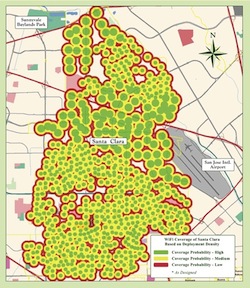
Free WiFi coverage in most of Santa Clara.
It’s a beautiful thing when the pieces fall into place and a city can maximize the value of past investments and decisions. Particularly when it means better and cheaper broadband service.
Santa Clara is rolling out an elegant solution for universal Internet access. The city owns and operates its own electric utility, and put in a fiber optic network to support it. The fiber’s reach is limited – it’s definitely not FTTH scale – but it’s enough to make broadband connectivity relatively easy throughout the city and keep the cost of Internet bandwidth down.
Along the way, the city picked up the remnants of a failed private WiFi service provider – MetroFi – and started installing smart meters for electricity customers. Which need to be networked.
So Silicon Valley Power, as the municipal electric utility is called, tied everything together to provide near-ubiquitous WiFi coverage and opened it up for free. Just a week into it, 3,000 people a day are connecting, according to the San Jose Mercury News.
Connection speeds are email-grade and security is minimal, but hey, it’s free. The public WiFi service as such won’t pay for itself. It’s not exactly being subsidized by the electric utility, since there’s little extra cost involved in letting public Internet access ride on the back of system that’s otherwise needed for operations.
An uncommon set of circumstances make it possible: a municipal electric utility and fiber optic backbone, a previous metro-scale WiFi system, and a smart meter upgrade. It’s definitely not a model for the majority of cities to follow, except in the sense that most have assets and resources that might help build better broadband, in one form or another. Palo Alto has a municipal electric utility and backbone fiber too, and is looking at WiFi options. San Leandro leveraged traffic signal conduit to jump start a commercial dark fiber network.
Santa Clara built a municipal broadband system by balancing the specific needs and wants of the community with available resources and realistic expectations. No hype, no drama. It’s an example to remember.
